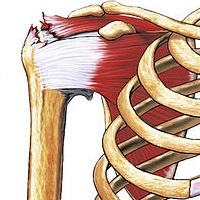
Photo from wikipedia
Failing to regenerate native tendon tissue in chronic massive rotator cuff tears (CMRCTs) results in high retear rates after surgery. Gelatin is a hydrolyzed form of collagen which is bioactive… Click to show full abstract
Failing to regenerate native tendon tissue in chronic massive rotator cuff tears (CMRCTs) results in high retear rates after surgery. Gelatin is a hydrolyzed form of collagen which is bioactive and biocompatible. This study intends to investigate the suitability of integrating gelatin to PLLA fibrous membranes for promoting the healing of CMRCTs. PLLA/Gelatin electrospun membranes (PGEM) are fabricated using electrospinning technology. The FTIR, static contact angles are tested sequentially. Cytocompatibility is evaluated with rat tendon fibroblasts and human umbilical endothelial cells (HUEVCs) lines. CMRCTs rat models are established and assigned into three groups (the sham group, the repaired group, and the augmentation group) to perform histomorphological and biomechanical evaluations. Gelatin is successfully integrated into PLLA fibrous membranes by the electrospinning technique. In vitro studies indicate that PGEM shows a great cytocompatibility for rat tendon fibroblasts and HUEVCs. In vivo studies find that applications of PGEM significantly promote well-aligned collagen I fibers formation and enhance biomechanical properties of the repaired tendon in CMRCTs rat models. In summary, gelatin promotes tendon fibroblasts and HUEVCs adhesion, migration, and proliferation on the PLLA fibrous membranes, and PGEM may provide a great prospect for clinical application. This article is protected by copyright. All rights reserved.
Journal Title: Macromolecular bioscience
Year Published: 2021
Link to full text (if available)
Share on Social Media: Sign Up to like & get
recommendations!